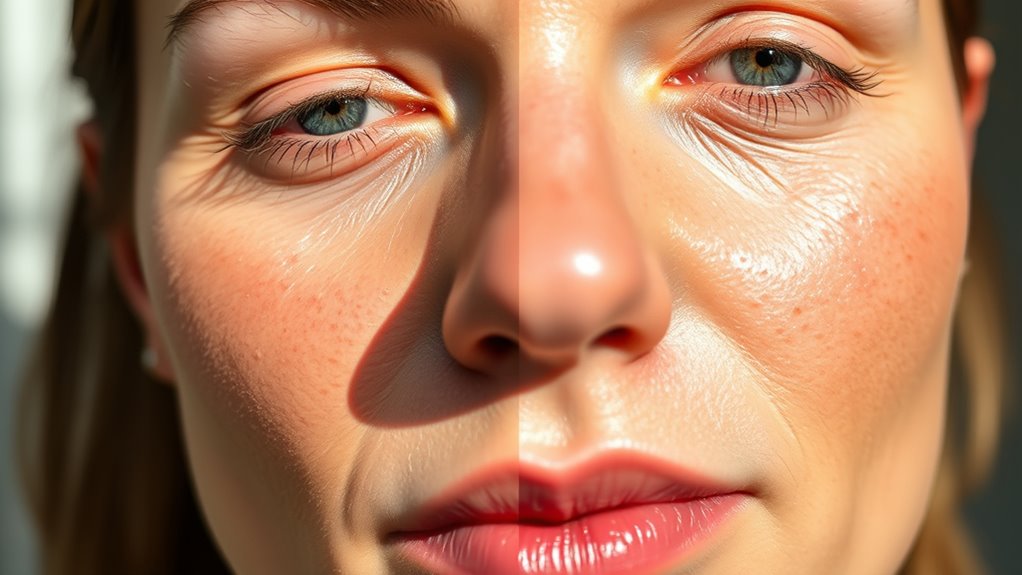To identify your skin type, start by cleansing your face gently and waiting about an hour without applying any products. Observe how your skin feels—notice if it feels tight, oily, or comfortable. Use a blotting paper on your face to see where oil appears most; no oil suggests dry skin, while oil in the T-zone indicates oily or combination skin. Keep exploring these signs, and you’ll uncover what works best for your skin.
Key Takeaways
- Wash your face with a gentle cleanser, dry it, and wait about an hour before assessing skin feel.
- Observe if your skin feels tight, uncomfortable, or flaky, indicating dry skin.
- Check for shine, pore size, and breakouts to distinguish oily or combination skin.
- Use a blotting paper on different areas; oil spots suggest oily or normal skin types.
- Note how your skin reacts and feels to determine if it’s dry, oily, normal, or combination.

Understanding your skin type is essential for choosing the right skincare routine and products. When you know whether your skin is oily, dry, sensitive, or a combination, you can tailor your approach to address your specific needs. This knowledge also helps you select effective treatments that reduce common skin concerns like acne, redness, or dullness. If you’re interested in natural skincare, understanding your skin type ensures you pick gentle, plant-based ingredients that won’t exacerbate issues or cause irritation.
Knowing your skin type helps you choose gentle, effective skincare and natural ingredients tailored to your needs.
To start, wash your face with a gentle cleanser and pat it dry. Wait for about an hour without applying any products. This waiting period allows your skin to reset, giving you an accurate reading of its natural state. Afterward, observe how your skin feels. If it feels tight, uncomfortable, or flaky, you likely have dry skin. If your skin appears shiny, especially in the T-zone (forehead, nose, chin), and you notice enlarged pores or breakouts, you probably have oily skin. If your skin feels comfortable but shows redness or reacts easily to certain products or environmental factors, you might have sensitive skin. For those who notice oiliness in some areas but dryness in others, or experience breakouts and flakiness simultaneously, you have combination skin.
Another method involves a simple blotting paper test. Gently press a piece of blotting paper on different areas of your face—forehead, nose, cheeks, and chin. Hold the paper up to the light and examine it. If the paper has no oil spots, your skin is likely dry. If it shows oil in the T-zone, you have combination or oily skin. A little oil on the cheeks suggests normal skin. This test gives you a visual cue to better understand your skin’s oil production and helps you select products that balance your skin’s natural moisture levels. Additionally, understanding skin type classification can help you better interpret the results of these tests and choose appropriate skincare strategies.
Knowing your skin type also guides you toward the most suitable ingredients and routines. For example, if you have sensitive skin, you’ll want to avoid harsh chemicals and opt for natural skincare products with calming ingredients like chamomile or aloe vera. Recognizing common skin concerns, such as redness, irritation, or breakouts, helps you choose targeted solutions that work with your skin’s natural balance rather than against it. By understanding your skin type, you can build a skincare routine that enhances your skin’s health, minimizes issues, and supports a more natural, glowing complexion. This knowledge keeps you from wasting money on products that aren’t suitable and encourages a more mindful, effective approach to skincare.
Frequently Asked Questions
How Often Should I Test My Skin Type?
You should test your skin type every few months to track changes in skin sensitivity and oiliness levels. Factors like weather, diet, and skincare routines can alter your skin, so regular checks help you adjust your products accordingly. Be mindful of any new sensitivities or changes in oil production, and retest to guarantee your skincare remains effective and balanced, ideally every 3 to 4 months.
Can Skin Type Change Over Time?
Imagine your skin as a chameleon—yes, it can change! Your skin type classification might evolve due to age, climate, or lifestyle. Skin type indicators like oiliness, dryness, or sensitivity can shift, so it’s wise to reassess periodically. Over time, your skin might become drier or more sensitive. Keep an eye on these signs to adapt your skincare routine accordingly, ensuring your skin stays healthy and balanced.
Does Climate Affect My Skin Type?
Climate effects definitely influence your skin type, causing it to adapt over time. In hot, humid weather, your skin may produce more oil, making it feel greasier, while cold, dry climates can lead to dryness and flakiness. You might notice your skin changing with the seasons as it adapts to the environment. So, paying attention to these climate effects helps you choose the right skincare and maintain healthy skin year-round.
Is My Skin Type the Same on Face and Body?
No, your skin type isn’t necessarily the same on your face and body. Facial skin often has different characteristics, like being more oily or sensitive, compared to the body, which may be drier or less prone to breakouts. These facial differences and body variations mean you might need different skincare routines for each area. Pay attention to how your skin reacts in each zone to customize your care effectively.
How Do I Differentiate Between Dry and Dehydrated Skin?
You can differentiate between dry and dehydrated skin by doing an oiliness assessment and checking moisture levels. Dry skin feels tight, rough, and flaky, with less oil production, while dehydrated skin may look dull, feel tight, and show fine lines due to lack of water, not oil. To tell, gently press your skin; if it’s flaky and rough, it’s dry. If it feels tight but not flaky, it’s dehydrated.
Conclusion
Once you know your skin type, it’s like having a personalized map guiding your skincare journey. I once thought I had oily skin until I realized my t-zone was greasy, but my cheeks were dry—like a city with busy streets and quiet neighborhoods. Knowing this helps you tailor your routine, just like a city planner designs roads for different areas. When you understand your skin, you reveal the secret to healthier, happier skin—your best guide yet.
Claire has a knack for turning complex dermatological concepts into engaging, easy-to-understand articles. Her work primarily focuses on creating detailed reviews and thought-provoking articles in the “Vetted” category. Claire’s writing not only informs but also inspires our community to try new skincare solutions.










